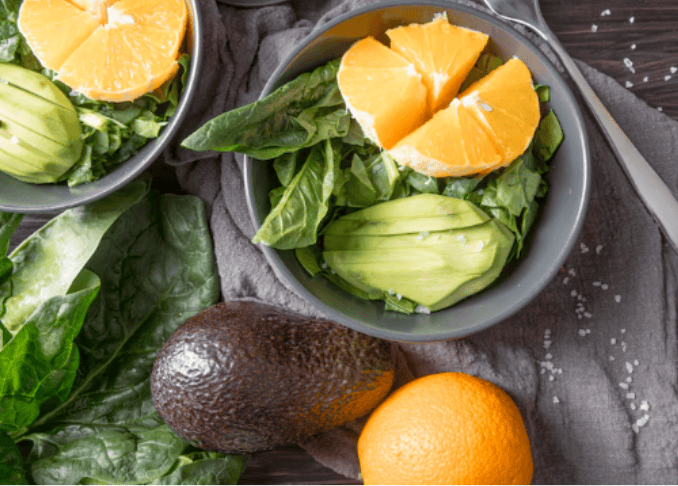Radiant skin doesn’t just come from what you put on your face—it begins with what you put in your body. More than ever, science supports the idea of “beauty from within,” where your diet directly impacts your skin’s hydration, brightness, and overall clarity.
If your skin feels dull, dry, or breakout-prone, the answer might not be in a serum—it could be in your next meal. Superfoods—those nutrient-packed whole foods loaded with antioxidants, vitamins, and healthy fats—can help you glow naturally by fighting inflammation, boosting collagen, and keeping your skin cells hydrated and protected.
From berries to avocados, certain foods don’t just nourish your body—they visibly improve your skin from within. This guide highlights the best superfoods for skin glow, backed by research and easy to add to your daily diet.
How Nutrition Impacts Skin Glow
What you eat shows up on your skin—sometimes more clearly than you think. The nutrients in your daily meals play a direct role in how your skin looks, feels, and ages over time. From boosting elasticity to calming inflammation, your diet has the power to transform your complexion from the inside out.
Key vitamins for skin glow—like A, C, and E—support skin regeneration, protect against free radicals, and maintain your skin’s natural barrier. Vitamin C also plays a vital role in collagen synthesis, which keeps your skin firm and youthful. Without enough of these nutrients, skin can appear dull, dry, or uneven.
Healthy fats, especially omega-3s, help maintain skin hydration and reduce inflammation, which is often behind acne flare-ups and redness. Antioxidants from colorful fruits and vegetables help fight oxidative stress, a major contributor to premature aging and skin damage.
Even mild dehydration can make skin look tired and dry. Staying hydrated and eating water-rich foods helps maintain that healthy, natural glow. And when your gut health is in balance—thanks to fiber and probiotics—your skin often reflects that clarity too.
In short, the connection between diet and skin health is real and powerful. Choosing skin-loving foods is one of the simplest ways to brighten your complexion—naturally.
Top 10 Superfoods for Glowing Skin
Want naturally radiant, healthy-looking skin? Start with what’s on your plate. These collagen-boosting foods and antioxidant-rich ingredients help your skin look its best from the inside out. Here are 10 science-backed superfoods for glowing skin and how to enjoy them daily.
1. Avocados
Avocados are packed with healthy monounsaturated fats, especially oleic acid, which helps keep skin soft, supple, and moisturized. They’re also rich in vitamin E, an antioxidant that protects against oxidative damage.
🧪 Research Insight: A 2022 study in Journal of Cosmetic Dermatology found that women who consumed one avocado daily for 8 weeks had improved skin elasticity and firmness.
How to Use: Add to smoothies, spread on whole-grain toast, or toss into salads.
2. Blueberries
These little berries are antioxidant powerhouses, especially rich in anthocyanins. They help fight free radicals, reduce inflammation, and support collagen strength—all key for smooth, radiant skin.
🧪 Research Insight: A 2021 study in Nutrients showed blueberry extract improved skin hydration and reduced wrinkle depth in middle-aged women.
How to Use: Eat fresh, blend into smoothies, or mix into yogurt bowls.
3. Fatty Fish (Salmon, Mackerel)
Fatty fish are loaded with omega-3 fatty acids, which reduce inflammation, help retain moisture, and improve skin barrier function. They’re also great sources of vitamin D and protein—both vital for skin repair.
🧪 Research Insight: A study in Lipids in Health and Disease (2020) linked omega-3 intake to reduced acne severity and improved skin hydration.
How to Use: Grill or bake salmon, or add mackerel to salads and grain bowls.
4. Sweet Potatoes
A vibrant source of beta-carotene, sweet potatoes help protect skin from sun damage and promote a natural glow. The body converts beta-carotene into vitamin A, which is essential for skin cell turnover.
🧪 Research Insight: According to American Journal of Clinical Nutrition, high beta-carotene intake is associated with a more golden, healthy-looking skin tone.
How to Use: Roast sweet potato wedges or mash with olive oil and herbs.
5. Spinach
Spinach is packed with skin-supportive nutrients like vitamins A, C, iron, and folate. Vitamin C boosts collagen production, while vitamin A promotes cell repair and turnover.
🧪 Research Insight: A review in Dermato-Endocrinology emphasized vitamin C’s role in collagen synthesis and antioxidant protection.
How to Use: Blend into smoothies, sauté with garlic, or enjoy raw in salads.
6. Tomatoes
Tomatoes contain lycopene, a powerful antioxidant shown to protect against UV-induced skin aging. Cooked tomatoes offer even higher lycopene levels.
🧪 Research Insight: A 2021 study in Photodermatology, Photoimmunology & Photomedicine found lycopene reduces UV damage and skin redness after sun exposure.
How to Use: Add cooked tomatoes to pasta, chili, or homemade sauces.
7. Nuts & Seeds (Almonds, Chia, Flax)
Almonds provide vitamin E, which helps skin retain moisture and fight inflammation. Chia and flaxseeds offer plant-based omega-3s and zinc, which aid in healing and reduce breakouts.
🧪 Research Insight: A study in Skin Pharmacology and Physiology (2019) linked almond consumption with reduced wrinkle severity and improved skin texture.
How to Use: Sprinkle seeds over oatmeal or yogurt; snack on a handful of almonds daily.
8. Green Tea
Rich in polyphenols like EGCG (epigallocatechin gallate), green tea helps reduce inflammation, protect against UV damage, and detoxify the skin from within.
🧪 Research Insight: In a 2020 Journal of Nutritional Biochemistry study, green tea extract improved skin elasticity, hydration, and density in women over 40.
How to Use: Drink 1–2 cups daily or apply chilled green tea topically as a toner.
9. Papaya
Papaya contains natural enzymes like papain that help gently exfoliate dead skin cells. It’s also high in vitamin C, which promotes brightness and helps fade dark spots.
🧪 Research Insight: International Journal of Dermatology (2021) reported papaya enzyme masks improved skin texture and reduced pigmentation after 4 weeks.
How to Use: Eat fresh or mash for a DIY face mask with honey.
10. Dark Chocolate (70%+ Cacao)
Yes, chocolate can be good for your skin—if it’s the dark kind. Dark chocolate is high in flavanols that improve skin hydration, increase blood flow, and protect from sun damage.
🧪 Research Insight: A clinical study in Journal of Nutrition found participants who ate dark chocolate daily had smoother skin and better UV resistance.
How to Use: Enjoy a small square as a treat or add cacao nibs to smoothies.
Lifestyle Tips to Maximize Skin Glow
Diet is just one part of the equation—your daily habits matter, too. A consistent natural skincare routine and healthy lifestyle help amplify your skin’s glow from the inside out.
Start with hydration. Drink at least 2 liters of water daily to keep your skin plump and radiant. Water helps flush out toxins and keeps your complexion clear.
Sleep is another skin essential. Aim for 7–8 hours per night to allow your body time to heal and regenerate. Poor sleep can lead to dullness, puffiness, and breakouts.
Daily sun protection is non-negotiable. Even on cloudy days, use SPF to prevent premature aging and sun spots. Don’t forget to manage stress, which can trigger inflammation and worsen acne.
Lastly, limit processed foods and sugar. They can spike insulin levels, leading to excess oil and clogged pores.
A balanced routine combining smart eating, skincare, and lifestyle changes is your best strategy for long-term, glowing skin.
Foods That May Dull Your Glow

Just as the right foods can boost your glow, the wrong ones can dull it. A dull skin diet often includes highly processed or sugary choices that affect both skin clarity and texture.
Refined sugar is a major culprit. It spikes insulin levels, leading to inflammation and increased oil production—both of which can trigger breakouts and dullness. For some people, dairy may also worsen acne or irritation due to hormones or sensitivities.
Processed foods—think packaged snacks, fast food, and frozen meals—often lack the skin-loving nutrients your complexion craves. They’re typically low in antioxidants and high in preservatives and additives.
Watch out for trans fats and high-sodium meals as well. These can disrupt blood flow and skin hydration, making your skin appear tired and dry.
A vibrant, radiant look starts with what you put on your plate. Steering clear of foods that harm skin health helps your natural glow shine through.
Frequently Asked Questions (FAQs):
How long does it take to see results from superfoods?
You may notice subtle skin improvements within 2–4 weeks of consistent intake. However, real transformation takes time. For most, glowing, balanced skin becomes more noticeable after 6–8 weeks of eating nutrient-rich whole foods.
Can diet really improve skin glow?
Yes! Diet directly impacts hydration, inflammation, and collagen production. Nutrients like vitamins A, C, E, healthy fats, and antioxidants help reduce dullness, support repair, and give your skin a brighter, healthier appearance over time.
Are these superfoods good for acne-prone skin too?
Many are! Foods like blueberries, green tea, and fatty fish have anti-inflammatory and antibacterial properties that may help calm acne. A superfoods-for-acne approach can support clearer skin when combined with a gentle skincare routine.
Should I take supplements or eat whole foods?
Whole foods are best. They offer a combination of nutrients, fiber, and antioxidants that supplements can’t fully replicate. However, if your diet lacks variety, targeted supplements may help—but always consult a healthcare provider first.
Which superfoods are best for dry vs oily skin?
For dry skin, focus on avocados, fatty fish, and nuts—they provide healthy fats and moisture. For oily skin, try green tea, tomatoes, and papaya to reduce oil and support balance with natural enzymes and antioxidants.
Conclusion
Glowing skin truly starts from within. The foods you eat directly shape how your skin looks and feels. These 10 superfoods—rich in vitamins, antioxidants, and healthy fats—nourish your skin from the inside out and help protect it against daily stressors.
By including a variety of them in your daily meals, you support hydration, collagen production, and natural radiance. Over time, your skin becomes clearer, softer, and more vibrant.
Remember, true skin health doesn’t come from quick fixes. Combine your superfood routine with plenty of water, sleep, sunscreen, and self-care for long-lasting results.
Let your plate do the work—and let your skin shine naturally.
